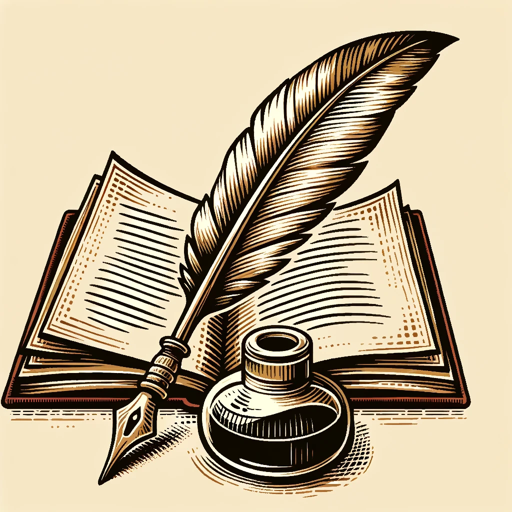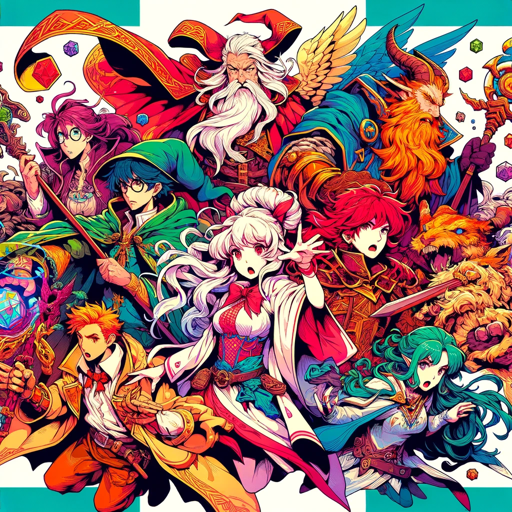✏ Narrative Craftsman ✏-tool for crafting messaging narratives.
AI-powered tool for strategic messaging.
Help refine my product or company's story
I need a structured outline for a slide deck for an analyst thought leadership session...
I would like to simplify my product elevator pitch
Simplify my product's story by using easy to understand anaologies
I need an outline for an AI strategy deck for my SaaS startup
Related Tools
Load More
✏️All-around Writer (Professional Version)
A professional writer📚 who specializes in writing all types of content (essays, novels, articles, copywriting)...

StoryCraft Studio
With the assistance of the upcoming ⚡SORA⚡, choose a setting idea that will define the narrative of your short film or video. Dive into a captivating vision of your SORA scenario, where every detail, crafted with GPT, is vividly brought to life through 📷p

Narrative Genius
Write with an AI partner that elevates your narrative to a professional, human-crafted masterpiece

Blog Mastermind | Creative Writing 🏆⚡🏆
Interactive blog creation guide, one paragraph at a time.
Storyline Author
Guiding in crafting detailed, narrative-driven chapters for stories.

Narrative Weaver
Crafts whimsical, fact-based fictional tales.
20.0 / 5 (200 votes)
Introduction to ✏ Narrative Craftsman ✏
Narrative Craftsman is a framework designed to build clear, authentic, and compelling messaging for B2B products. Its primary goal is to craft strategic narratives that resonate with a specific target audience by addressing their pain points and presenting a solution in a relatable, jargon-free manner. The framework emphasizes market analysis, positioning, and value articulation. It seeks to break away from overused jargon and corporate speak, instead opting for messaging that feels human and benefits-driven. For example, if you're launching a software that simplifies workflows, Narrative Craftsman would focus on clearly explaining how the software reduces time spent on mundane tasks rather than using vague claims like 'optimize operations.' This approach ensures that the messaging feels relevant and understandable to both technical and non-technical buyers, making it easier to convey value. Additionally, the framework helps businesses avoid high-revenue, bad-fit customers by tightening positioning and focusing on ideal customer profiles (ICP), allowing for long-term profitability and growth.

Main Functions of ✏ Narrative Craftsman ✏
Market and Customer Analysis
Example
Identify customer pain points and challenges by diving deep into their day-to-day struggles.
Scenario
For instance, when launching a new CRM, Narrative Craftsman would first investigate how sales teams currently manage customer data, highlighting inefficiencies such as manual entry, and then show how the new CRM automates these processes.
Strategic Messaging Development
Example
Develop clear, human-centered messaging that avoids jargon and corporate buzzwords.
Scenario
A SaaS company might be tempted to describe its platform as 'best-in-class' or 'revolutionary.' Instead, Narrative Craftsman would help them say something more concrete, like 'Our platform helps reduce your customer service response time by 30%.' This makes the message clearer and more relatable, especially to overwhelmed B2B buyers【21†source】.
Differentiation and Positioning
Example
Highlight both competitive and contextual differentiation to show how the product is better than the competition and an improvement on current processes.
Scenario
If a company is launching a time-tracking tool, Narrative Craftsman might position the product not only as faster and easier to use than competitors, but also as a major improvement on how companies currently track hours through spreadsheets. This type of positioning makes the tool more attractive to buyers.
Ideal Users of ✏ Narrative Craftsman ✏
Product Marketing Managers (PMMs)
PMMs looking to launch new products or revamp existing offerings would benefit greatly from Narrative Craftsman’s structured approach to positioning and messaging. It helps PMMs align their teams internally and externally, ensuring that they clearly communicate the unique value of their products, avoid bad-fit customers, and resonate with their target market【22†source】.
B2B SaaS Companies
SaaS businesses, especially those targeting multiple decision-makers or needing to prove ROI early in the buying process, can leverage Narrative Craftsman’s ability to clarify the product's value without relying on overly technical language. This ensures that their solutions are easily understood and their value perceived by a broad audience of potential buyers【23†source】.

How to use ✏ Narrative Craftsman ✏
Visit aichatonline.org for a free trial without login, no need for ChatGPT Plus.
Start by exploring the platform without any commitment or paid subscription, allowing you to get a feel of the tool's capabilities.
Define your target customer and problem statement.
Identify your ideal customer profile, their goals, and the specific problem they are trying to solve. This helps focus your messaging framework effectively.
Link product features to customer pain points.
Match your product’s key features to the challenges your target customers face, ensuring that the value of your product is clearly communicated.
Develop a customer-centric narrative.
Craft messaging that speaks directly to the customer's perspective, using relatable language and avoiding jargon to ensure clarity and resonance.
Review and refine messaging using peer feedback and self-service options.
Use reviews, trials, and data-driven insights to continuously test and improve your messaging for better market engagement and ROI.
Try other advanced and practical GPTs
Patent Ally
AI-powered solutions for patent applications

WebGL - Web Graphics Library
AI-powered WebGL development assistant.

God's Information Systems Design
AI-Powered Information Systems Design Guide

结构化提示词工程师v4.0
AI-powered structured prompt generation
Proofreader
AI-powered proofreading for flawless writing.

Motivation Coach ZAZE: Conquer Apathy Live Life
AI-driven motivation to conquer apathy.

IB Business Management Companion
AI-powered study guide for IB Business Management.
Suno V4
AI-Powered Solutions for Every Task

TRPG 立ち絵メーカーVer0.1
AI-powered character creator for TRPGs.

Cheat Engine AI
AI-powered Cheat Engine scripting and optimization.

Apify Adviser
AI-powered web scraping and automation tool.

Double Vision
AI-powered ultra-realistic image creation

- Product Launch
- Value Proposition
- Positioning Strategy
- B2B Messaging
- Customer Alignment
Q&A about ✏ Narrative Craftsman ✏
What is the core purpose of Narrative Craftsman?
Narrative Craftsman helps B2B businesses create compelling, customer-focused messaging by linking product features to specific customer pain points and avoiding jargon. It emphasizes clear communication and ROI-focused narratives.
How can Narrative Craftsman improve my product launch?
It offers a structured approach to crafting strategic messaging for both external and internal launch workstreams, ensuring alignment across teams and clear positioning to the market.
What makes Narrative Craftsman different from other messaging frameworks?
It focuses on competitive and contextual differentiation, linking product value to both market competitors and current customer behaviors, ensuring your product stands out in a crowded space.
How does Narrative Craftsman avoid bad-fit customers?
By tightening your positioning and adhering to an ideal customer profile (ICP), it helps you avoid customers who drain resources or deviate from your long-term vision.
What resources does Narrative Craftsman recommend for proving product value to buyers?
It emphasizes the use of self-serve options like demos, free trials, and authentic peer reviews to show ROI and build trust with modern B2B buyers.